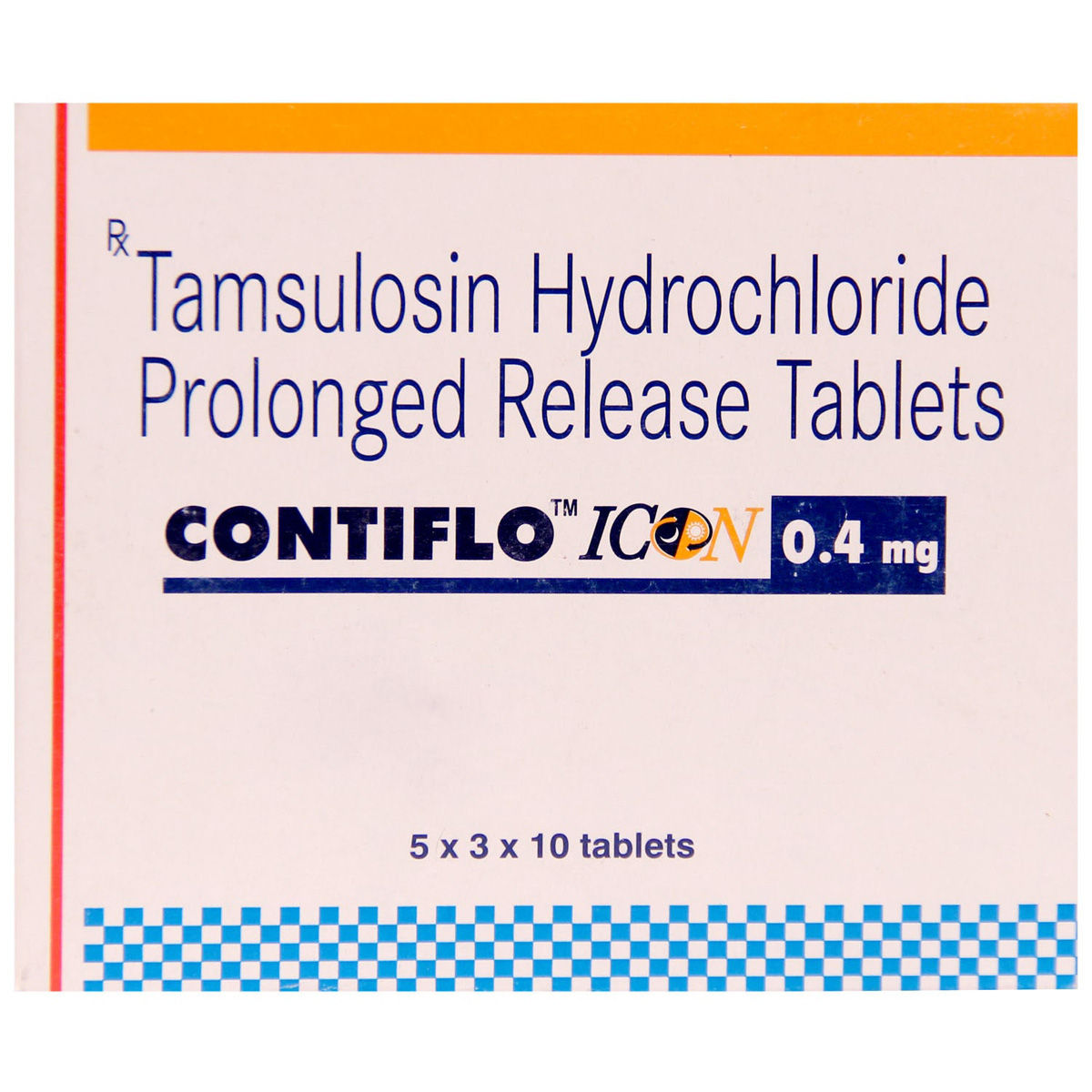Tamsulosin
About Tamsulosin
Tamsulosin is an alpha-blocker used primarily to treat Benign Prostatic Hyperplasia (BPH), also known as an enlarged prostate, and urinary bladder outlet obstruction. Tamsulosin does not cure prostate cancer but helps manage the symptoms caused by BPH, such as difficulty passing urine and frequent urination. BPH is a non-cancerous growth of the prostate gland caused by excessive production of the hormone dihydrotestosterone (DHT), which can obstruct urine flow.
Tamsulosin contains Tamsulosin, an alpha-blocker that works by relaxing the muscles in the prostate gland and the urinary bladder neck at the obstruction site. This helps improve urine flow, relieving the symptoms of BPH, such as difficulty in urinating and frequent urination.
Common side effects include low blood pressure (hypotension), dizziness, drowsiness, reduced libido, impotence, breast tenderness or enlargement in men, insomnia, runny nose, and ejaculatory problems. These side effects typically improve with continued use, but if they persist, consult your doctor.
Tamsulosin is not suitable for women or children. Before starting the medication, inform your doctor if you have low blood pressure, liver or kidney disease, or any heart problems. Tamsulosin can pass into semen, so it is advised to use a condom during sexual intercourse, especially if your partner is pregnant. Do not donate blood while taking Tamsulosin, but you can donate 6 months after your last dose. Patients taking Tamsulosin should be cautious when driving or operating machinery due to potential dizziness or drowsiness. In rare cases, if you experience prolonged issues with erection, ejaculation, or pain in the penis, contact your doctor immediately.
Uses of Tamsulosin
Medicinal Benefits
- Tamsulosin contains Tamsulosin (an alpha-blocker), which is primarily used to treat Benign Prostatic Hyperplasia (BPH), or an enlarged prostate in males.
- Tamsulosin helps alleviate urinary issues like difficulty passing urine and frequent urination associated with BPH.
- It works by relaxing the muscles around the bladder exit and prostate gland, making it easier to pass urine.
- Tamsulosin improves urine flow, reduces hesitancy, and helps with incomplete bladder emptying.
- Overall, Tamsulosin effectively relieves the symptoms of BPH and improves urinary function.
Directions for Use
- Take Tamsulosin 30 minutes after meal or as advised by the doctor.
- It is advised to take Tamsulosin once daily; however, follow your doctor’s recommendation regarding the dosage and duration.
- Swallow Tamsulosin as a whole with a glass of water.
- Do not crush, chew or break it.
Storage
Side Effects of Tamsulosin
- Low blood pressure (hypotension)
- Dizziness
- Drowsiness
- Reduced sex drive (libido)
- Inability to get an erection (impotence)
- Tenderness or enlargement of your breasts (in men)
- Sleeplessness
- Runny nose
- Ejaculatory problems
Drug Warnings
- Inform your doctor if you are allergic to any medicines or foods, or if you have medical conditions such as liver or kidney disease, low blood pressure, a history of prostate cancer, heart disease, or are planning to undergo cataract surgery.
- Use a condom during sexual intercourse, as Tamsulosin passes into semen and can affect pregnant women and the fetus. Always consult your doctor for advice.
- Do not donate blood while taking Tamsulosin. You can donate 6 months after your last dose.
- Caution is advised when driving or operating machinery as Tamsulosin can cause drowsiness or dizziness.
- Inform your doctor about all prescription and non-prescription medicines, vitamins, supplements, and herbal products you are taking to avoid interactions.
- Tamsulosin is intended for male patients only and should not be used by women or children.
- In rare cases, if you experience erection problems, ejaculation issues, or pain in the penis, contact your doctor immediately.
Drug Interactions
Drug-Drug Interactions: Tamsulosin may interact with certain antibiotics (clarithromycin, erythromycin, doxycycline), antidepressants (fluoxetine, paroxetine), antifungals (itraconazole and ketoconazole), blood pressure-lowering pills (atenolol, metoprolol, prazosin, terazosin), pain killers (diclofenac, ibuprofen, indomethacin).
Drug-Food Interactions: Tamsulosin is known to interact when taken along with alcohol. Also, keep your doctor informed about all the OTC medicines you are using while taking Tamsulosin.
Drug-Disease Interactions: Tamsulosin may interact if you have glaucoma, liver/kidney disease and hypotension (low blood pressure).
Drug-Drug Interactions Checker List:
Safety Advice

Alcohol
unsafeTamsulosin should not be taken with Tamsulosin as it may cause low blood pressure (orthostatic hypotension), dizziness and drowsiness. Keep your doctor informed if you drink alcohol.

Pregnancy
not applicableTamsulosin is only for use in male-only and not female.

Breast Feeding
not applicableTamsulosin is only for use in male-only and not female.

Driving
cautionTamsulosin can make some people feel dizzy, so it may affect your ability to drive or operate machinery safely.

Liver
cautionTamsulosin should not be taken until prescribed. Regular monitoring of liver function tests is recommended.

Kidney
cautionTamsulosin should not be taken until prescribed. Regular monitoring of kidney function tests is recommended.

Children
unsafeTamsulosin is not recommended for children. The safety and effectiveness of Tamsulosin have not been established in children due to limited testing of this drug on children by competent authorities worldwide.
Habit Forming
Diet & Lifestyle Advise
- Avoid drinking less alcohol, caffeine, and fizzy drink. Limit intake of artificial sweeteners.
- Maintain a healthy lifestyle and exercise regularly, so you do not feel heavy in the abdomen.
- Also, drink less water in the evening and before sleeping to have a sound sleep and do not wake up frequently for urination.
- Any medication that may worsen urinary symptoms (for cold and cough) should be avoided.
Special Advise
- Tamsulosin is not intended for use as an antihypertensive (blood pressure-lowering) drug.
- Don't stand suddenly from a lying or resting position, as it may increase the risk of falls due to a sudden dip in blood pressure (orthostatic hypotension).
Patients Concern
Disease/Condition Glossary
Benign prostatic hyperplasia (BPH): The enlargement of the prostate gland is benign prostatic hyperplasia (BPH). It is a non-cancerous growth of the prostate gland caused due to overproduction of dihydrotestosterone hormone in men. After age 50, most men develop an enlarged prostate gland putting pressure on the urinary bladder. It leads to restricted or obstructed urine flow, an urge to urinate frequently (especially at night), and a feeling of not emptying the urinary bladder.
FAQs
Tamsulosin is primarily used to treat Benign Prostatic Hyperplasia (BPH), which is an enlarged prostate gland that leads to urinary problems. These problems may include difficulty passing urine, frequent urination, and incomplete bladder emptying.
Tamsulosin contains Tamsulosin (an alpha-blocker), which is primarily used to treat an enlarged prostate gland that causes urinary problems, such as difficulty passing urine and frequent urination. Tamsulosin works by relaxing the muscles in the prostate gland and the urinary bladder neck, at the site of obstruction. This results in improved urine flow and relief from BPH (Benign Prostatic Hyperplasia) symptoms.
Tamsulosin should not be used in children under 18 years or in women. It is recommended for male-only use. Tamsulosin should not be given to individuals with prostate cancer, priapism (a painful, persistent penile erection unrelated to sexual activity), low blood pressure (hypotension), cataracts, or those who are allergic to Tamsulosin or sulfa drugs.
No, taking any cold or cough medication along with Tamsulosin should be avoided as it increases the urge to urinate. So, before taking any such medication, please consult your doctor.
No, you are advised not to donate blood if you are taking Tamsulosin. Even if you stop taking Tamsulosin, wait for at least 6 months and consult your doctor before donating blood.
Intake of Tamsulosin may cause a sudden drop in your blood pressure leading to orthostatic hypotension. It usually occurs when one suddenly stand from a lying or resting position which may increase the risk of falls.
No, Tamsulosin does not cure benign prostatic hyperplasia (BPH) helps in relieving symptoms of the enlarged prostate gland. For better advice, you should consult your doctor.
The side effects of Tamsulosin include dizziness, drowsiness, sleeplessness, runny nose, low blood pressure and libido (reduced sex drive). If these side effects persist or worsen, please consult your doctor.
Tamsulosin can be taken after breakfast or after the first meal of the day. However, some doctors advise taking it at night time after dinner. You should take it approximately 30 minutes after the same meal every day. Swallow it as a whole with a glass of water. Do not crush, chew or break it.
Tamsulosin does not increase blood sugar levels. However, if you notice any change in the blood sugar levels while using Tamsulosin, consult your doctor as this may indicate a medical condition which needs attention.
No, Tamsulosin does not cause any weight gain generally, even on long-term use. However, if you experience any weight gain while taking Tamsulosin, please consult your doctor to identify the cause of the weight gain.
Tamsulosin shows improvement in urine flow in 4 to 8 hours after taking it. However, it may take 2 to 4 weeks to show its full effect.
Yes, you may take Tamsulosin with vitamin D as no harmful effects or interactions have been reported when these are used together. However, please consult your doctor before taking Tamsulosin with other medicines or supplements.
Tamsulosin helps in removal of kidney stones through urine. It works by relaxing the urinary tract muscles which makes it easier to remove stones. Use of Tamsulosin in kidney stones also decreases the need for painkillers.
Tamsulosin widens the blood vessels and leads to the accumulation of blood in the extremities (ends of the arms and limbs). This prevents the proper flow of blood to the brain, which lowers blood pressure on the sudden change in posture. Therefore, the patient may experience dizziness, fainting, lightheadedness, spinning sensation, and vertigo.
Tamsulosin can cause floppy eye syndrome in which the iris muscles become floppy and the pupil constricts unexpectedly during cataract surgery. So, when the eye surgeon actually needs a dilated pupil, it will constrict and restrict the field of surgery, and may have an impact on the surgical outcomes.
Tamsulosin relaxes the smooth muscles of the blood vessels and this dilation of the blood vessels can cause a stuffy nose.
No, Tamsulosin is not an anticholinergic. Tamsulosin is an alpha blocker which relaxes the prostate gland’s muscles and urinary bladder neck, resulting in improved urine flow in patients with benign enlargement of the prostate gland.
No, Tamsulosin does not cause frequent urination. In fact, it increases the urine flow and decreases the need to urinate frequently, which is a sign of benign enlargement of the prostate gland. Additionally, this condition leads to a weak stream of urine, making it difficult for the patient to empty their bladder completely.
The long-term use of Tamsulosin may increase the chances of having infection, pain, rhinitis (irritation and inflammation of the mucous membrane inside the nose), and pharyngitis (inflammation of the back of the throat). Also, it may cause blackouts, abnormal ejaculation, faintness, dizziness, lightheadedness, and decreased blood pressure.
Try to urinate when you initially feel the urge. However, be careful not to strain or push to empty your bladder. Avoid drinking fluids (especially caffeine, alcohol) a few hours before bedtime or going out. Also, do not take any other medicine without consulting your doctor as some medicines may increase your urge to urinate.
You are recommended to consult your doctor before taking Tamsulosin with ibuprofen or paracetamol or other medicines.





